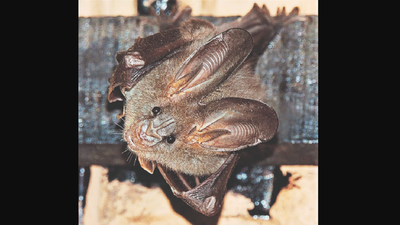- News
- City News
- bengaluru News
- Female bushcrickets hunted more than males, reveals radio tracking
Trending Topics
Female bushcrickets hunted more than males, reveals radio tracking

Researchers found out that the females moved 1.5 times more frequently and 1.8 times farther than the males.
BENGALURU: A recent study conducted by a group of researchers at the Centre for Ecological Sciences (CES), Indian Institute of Science (IISc), revealed that female katydids are at greater risk than their male counterparts – probably because the “former are frequent fliers covering longer distances”.
To understand how katydids (bushcrickets) get hunted by their predators — the lesser false vampire bat — a group of researchers led by Rohini Balakrishnan, professor at CES, had fitted tiny radio tags onto these insects and tracked their movements in the canopy.
Published in ‘Behavioral Ecology and Sociobiology’, this is the first radio tracking of insects in India, said Harish Prakash, a postdoc at CES and an author of the research paper. “In earlier studies, Balakrishnan and the others had found there were a lot more remnants of female wings than males, suggesting that bats preferred to prey on female katydids. This led the researchers to ask the question: What is it about katydid females that make them more attractive to the bats?
One possibility is that the bats can detect the females more easily, since they are usually larger than males. Second, female katydids might be more nutritious than males and therefore the preferred bat diet.
To test these possibilities, researchers focused on a group of katydids called “whistlers”, in which females were almost double the size and weight of males. “Surprisingly, the bats approached both males and females with equal frequency.” So, the size and nutritive value of females as possible reasons behind predation were ruled out, the research paper stated, which led them to a third possibility.
Researchers wondered whether the females were flying out more often. To test this, the team glued tiny radio transmitters onto the backs of male and female katydids and tracked them.
Soon, researchers found out that the females moved 1.5 times more frequently and 1.8 times farther than the males.
This led them to conclude that flying more frequently and travelling longer distances across trees were exposing the females to a higher risk of being hunted than the males. Balakrishnan said in systems where males produce conspicuous acoustic signals and females move silently, it has been assumed that males, rather than females, perform the higher-risk behaviours. “However, contrary to this view, the current study shows female katydids may be at greater risk of predation,” he added.
To understand how katydids (bushcrickets) get hunted by their predators — the lesser false vampire bat — a group of researchers led by Rohini Balakrishnan, professor at CES, had fitted tiny radio tags onto these insects and tracked their movements in the canopy.
Published in ‘Behavioral Ecology and Sociobiology’, this is the first radio tracking of insects in India, said Harish Prakash, a postdoc at CES and an author of the research paper. “In earlier studies, Balakrishnan and the others had found there were a lot more remnants of female wings than males, suggesting that bats preferred to prey on female katydids. This led the researchers to ask the question: What is it about katydid females that make them more attractive to the bats?
One possibility is that the bats can detect the females more easily, since they are usually larger than males. Second, female katydids might be more nutritious than males and therefore the preferred bat diet.
To test these possibilities, researchers focused on a group of katydids called “whistlers”, in which females were almost double the size and weight of males. “Surprisingly, the bats approached both males and females with equal frequency.” So, the size and nutritive value of females as possible reasons behind predation were ruled out, the research paper stated, which led them to a third possibility.
Researchers wondered whether the females were flying out more often. To test this, the team glued tiny radio transmitters onto the backs of male and female katydids and tracked them.
Soon, researchers found out that the females moved 1.5 times more frequently and 1.8 times farther than the males.
This led them to conclude that flying more frequently and travelling longer distances across trees were exposing the females to a higher risk of being hunted than the males. Balakrishnan said in systems where males produce conspicuous acoustic signals and females move silently, it has been assumed that males, rather than females, perform the higher-risk behaviours. “However, contrary to this view, the current study shows female katydids may be at greater risk of predation,” he added.
Start a Conversation
FOLLOW US ON SOCIAL MEDIA
FacebookTwitterInstagramKOO APPYOUTUBE










